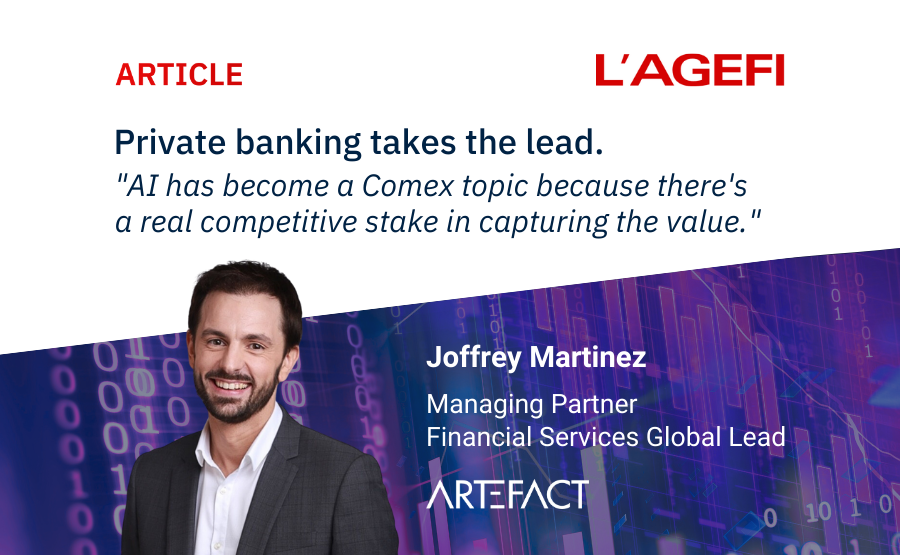In the face of upheavals of all kinds, private banking plays on its values to stay the course. For its customers and to meet its own challenges, it intends to be present. That’s what the Forum de la Gestion Privée 2025 is all about.
It’s one of the cornerstones of our business. Private banking has a special relationship with its customers, based on long-term relationships and intuitu personae. Now, with political instability in France following the dissolution of the National Assembly last June, an international environment that is hostile, to say the least, given geopolitical tensions and, more recently, the consequences of the trade war with the Trump administration, private banking is in the spotlight. The onus is on it to assert its values to its customers and to face up to its own challenges, based on digital transformation, allocation or opening up to new asset classes such as private assets, or even cryptos… One of the greatest challenges facing private banking is undoubtedly to have to do everything at once. It’s against this backdrop that L’Agefi’s Forum de la Gestion Privée is being held this year, with the ambition of thinking big and embracing the broadest possible range of issues.
In practice, for the second year running, the Forum opened up to the ecosystem by devoting a morning of debates to wealthtech players, and in particular to the issues surrounding artificial intelligence. Like a keystone in the world of private wealth management, family offices were also present to discuss their role in supporting the real economy and financing innovation. All that remained was for the players in the private banking world to exchange ideas on the various themes. Clearly, there was no shortage of them.
A look back at the major trends that have emerged over the last twelve months, in a context marked by profound upheaval…
Supporting customers in times of crisis pays off.
Of the various events that have occurred since last year, the most important for private bank customers remains the dissolution of the French National Assembly. It initially generated fear, then questions,” recalls Jean-Marc Ribes, President of Banque Richelieu France. There was renewed interest in Luxembourg life insurance and, in the bank, we actually recorded a higher number of calls for information. On the other hand, we didn’t get any requests for specific appointments, given that in a single day we could hear anything and everything… The situation then gradually stabilized, and there was no mass exodus, or even any remarkable movements. Customers put themselves ‘on hold’ and showed maturity.“
Proximity and advice
Alain Hervé, Chairman of the Management Board of Arkéa Banque Privée, emphasizes the territorial and mutualist identity of his establishment, a subsidiary of Crédit Mutuel Arkéa. “We are very close to our loyal regional customers, most of whom are business leaders who, despite the economic uncertainties and recent crises, have kept their cool. There has been no desire to go into tax exile, particularly on the part of our clientele, which is mainly made up of wealthy clients and company directors who have not wished to relocate their work tools,” he explains. Even so, Alain Hervé points out that private bankers have chosen to adopt a proactive strategy, by calling their customers. “This personalized approach has fostered trust and limited the need to make hasty decisions,” he adds.
“The arrival of Donald Trump as President of the United States has not been synonymous with fears, but rather with opportunities, exposing our customers to this geographic zone until the end of 2024.” Jean-Marc Ribes, President, Richelieu Bank France.
For his part, Pierre Marin, co-founder and chief executive officer of private bank RockFi, noted that wealthy clients have indeed demonstrated an increased need for personalized wealth advice. But when it comes to instability, Pierre Marin went further than the political and international crises, pointing to the growing complexity of the banking world. We’ve never seen so many mergers & acquisitions and other capital-intensive operations in the major French banks,” he points out. Banking organizations are becoming increasingly cumbersome and bureaucratic. Private bankers, and a fortiori their customers, have a hard time finding their way around. Added to this is the instability of customer portfolios, which change every two or three years, and IT systems...
The safety card
It’s a fact that there was no panic or extreme behavior, such as capital flight. But customer reactions nevertheless varied from one establishment to another. The arrival of Donald Trump as President of the United States was not synonymous with fears, but rather with opportunities, as we exposed our clients to this geographic zone until the end of 2024,” confirms Jean-Marc Ribes. Conversely, valuation levels, as well as certain political decisions – in particular concerning tariffs – led us at the beginning of 2025 to arbitrate the United States in favor of Europe, which has since performed well.“
Alain Hervé, for his part, noted a fairly clear shift in allocations. “We have seen a greater securitization of assets“, he reports. This manifested itself in a return to Europe after international exposure, particularly in the United States during Donald Trump’s election, and also in greater diversification. There’s a reason for this: “Company directors, having devoted their professional lives to their business, want highly secure asset management. To meet these expectations, we have called on the bank’s wealth engineering teams to support them in tax, inheritance and strategic matters.“
In terms of asset allocation, this desire to secure assets and benefit from prudent management has led to a strong revival of interest in capital-guaranteed structured products. There are also some nuances from one bank to another. At Arkéa Banque Privée, in addition to Luxembourg life insurance and premium real estate via club deals, unlisted assets such as debt, infrastructure and private equity have seen increased demand. “It’s a question of diversification in response to persistent market volatility,” notes Alain Hervé.
At RockFi, three major investment trends have also emerged. The appetite for structured products, growing interest in Luxembourg life insurance and exchange-traded funds (ETFs), particularly those investing in the defense sector. These trends were reinforced by a proactive approach on the part of our private bankers,” explains Pierre Marin. They didn’t wait for customers to express their doubts before accompanying them.“
Matthieu Guignard, Director of Services and Solutions in Amundi’s Distribution & Wealth division, reminds us of the fundamental trends that have swept through private banking since the start of 2024. Three major trends have been observed for several years and have accelerated over the past twelve months,” notes the manager. Firstly, changes in regulations, in particular the Retail Investment Strategy and Value for Money, which require the quality of products to be assessed in relation to their management fees. Secondly, the accelerating digitalization of the customer experience, both in self-care and with advisors. This enables us to evolve our offerings by industrializing processes, while maintaining a certain degree of personalization. Finally, a third trend concerns the use of tools enabling an industrial approach to customer segmentation in advised and discretionary management: standardized, often ETF-based, management accessible from a few thousand euros for the more mainstream segments, and a more personalized approach to mandates for the more upmarket segments.”
Private banks in tune with family officers.
Times have changed. Family offices are increasingly appealing to individual investors, and in themselves illustrate a profound change in the wealth management sector. Seeking a comprehensive, tailor-made service, private clients are now increasingly selective and critical of the professionals who work with them. In this respect, the independence of family officers and multi-family officers is convincing. This is especially true of the 35-40 age group.
If codes are evolving, it’s above all because part of the previous generation placed almost total trust in institutions. A well-known name could quickly tip the balance for some, while the new generation is proving to be more informed. Above all, their expectations are evolving towards greater transparency in decision-making, immediacy in information needs, and commitment, particularly on a human level. In this context, how are private banks adapting?
Enriching the customer experience
The point is not to pit the players against each other, but to understand how private banks are evolving to remain strategic partners for family officers. It’s up to them to go beyond the simple posture of banker. Long criticized for their focus on “in-house products”, private banks are now expanding their range of services. For some, open architecture has enabled them to broaden their offering. Passive management, in particular through the use of ETFs within an allocation, is increasingly used, whereas it was generally avoided for high net worth individuals. Some players are also differentiating themselves by offering crypto-currencies. By modulating their product offering, private banks are also responding to a need for diversification.
At the same time, more and more companies are investing heavily in the digitization of their customer paths. Although the human relationship remains central to the customer experience, many steps can be automated, accelerating processes and the speed of response between advisor and customer. This does not mean dehumanizing the relationship, but rather enriching it by enabling greater responsiveness and fluidity, while retaining the DNA of personalized advice.
On the other hand, customers are becoming less and less loyal, no longer hesitating to multiply the number of financial players involved, and to walk away if they’re not satisfied. This is why greater agility, combined with proximity to the customer, seems essential. What will make the difference tomorrow is not products, but the ability to offer a global, fluid, human and ultra-personalized customer experience. Only then will private banks continue to play a central role in wealth management.
AI enters private banking in small steps.
Private banks won’t be the “early adopters” of artificial intelligence (AI)! “We’re watching and starting to receive solutions providers,” concedes the majority of panelists at the round table dedicated to the subject. BNP Paribas Wealth Management clearly stands out, as it has been looking into the subject for several years and has deployed several solutions responding to different use cases. An exception among private advisors, even if they all seem interested in the potential gains to be made.
For many, it’s mainly a question of increasing productivity in low value-added day-to-day tasks (legal and sector watch, etc.), thanks to AI agents acting as virtual assistants. But BNP Paribas WM goes one step further with content generation and translation tools, such as recommendations. Its advisors also benefit from assistance in preparing customer meetings.
“The challenge of AI models in our sector is to be able to process unstructured data, which is very often the case in our businesses,” explains its chief digital and data officer, Mariam Rassai. Information can be gathered verbally during a telephone appointment, by e-mail, and is not all represented in the same format.” Joffrey Martinez, managing partner – global financial services lead at Artefact, supports financial companies in their AI & data transformation.
He points out that financial companies are using AI to target three main types of objectives: greater efficiency, generating additional revenue, and protecting themselves (fraud, AML, cyber…).
Many obstacles
But if AI is struggling to gain a foothold in private banking and wealth management, it’s above all because the offering is not yet fully convincing. “We need specific tools. Ready-to-use solutions don’t yet perfectly match our expectations, and building a customized AI tool is very expensive“, testifies Lucas Mazet, head of tools and digital transformation at multi-family office Ivesta FO. Following on from this, it’s important to understand that not all establishments are prepared to mobilize internal resources to develop their own tools.
“To keep IT costs under control, teams need to be empowered to take on some of the application maintenance for these solutions,” adds Joffrey Martinez. He adds that corporate culture can also be a major obstacle: “This is very much the case in large companies. You have to make sure that employees really need the solution, to avoid making unnecessary efforts.
At BNP Paribas WM, it took several years to deploy tools adapted to its different business lines. “We develop our use cases with the user teams, going through a scoping phase, building a library of prompts (instructions given to an AI model to generate a response, editor’s note) and qualitative and quantitative tests to ensure that the results meet several quality standards,” explains Mariam Rassai.
Training and convincing employees: a challenge for financial companies
The financial and material cost is particularly high in the private asset management sector, as Alexandre Hezez, Director of Collective Management and Strategist at Richelieu Group, points out: “Security processes are fundamental in finance. The deployment of new tools is often very slow and represents a more or less significant cost.” Security risks are also highlighted, particularly by Lucas Mazet, who believes that “current solutions do not offer sufficient safeguards to enable widespread use by employees“. In fact, this is the main point that has prompted our experts’ companies to severely restrict the use of consumer tools such as ChatGPT internally. Only BNP Paribas WM has chosen to use the enterprise version of the tool that launched the democratization of AI.
Customer pressure
While private advisors are struggling to find a completely satisfactory offering, they know that their customers are waiting with bated breath to adopt AI. After playing around with the freely available tools for a while, they’re now realizing that they’re of interest in areas other than leisure. “More and more customers, particularly international ones, are using AI to better understand their portfolios and the legal issues we discuss with them,” confirms Alexandre Hezez. This is a real challenge for our businesses, as it is profoundly changing the nature of our exchanges.“
“Artificial intelligence has become a comex topic, as there’s a real competitive challenge in capturing value.”
JOFFREY MARTINEZ, managing partner global financial services lead at Artefact
Customer pressure is likely to continue to grow as their everyday banks adopt AI. “In the financial sector, retail networks are more advanced because their volume makes the deployment of AI tools more easily profitable,” explains Joffrey Martinez, who nevertheless says he has been receiving more requests from asset managers and private clients since the beginning of the year. “AI has become a comex topic because there’s a real competitive stake in capturing value,” adds Joffrey Martinez.
Little by little, AI is making its mark. Adoption by private banking establishments seems destined to become widespread. Nevertheless, the question of actual use by employees may arise. While the French have become familiar with AI in their private lives, they have yet to switch over to more professional use. As habits die hard, the challenge for financial companies will also be to train and convince employees to change the way they work. ■
Luxembourg life insurance capitalizes on its strenghts.
In an ever-changing economic, social and financial environment, life insurance remains an essential pillar of wealth management. Whether as an attractive tax wrapper, long-term investment, project financing or estate planning tool, there are many reasons to invest in life insurance. If the assets invested in the French envelope have never been as high as they are today – over 2,000 billion euros – the sector owes this in particular to a strong savings dynamic, but also to the sophistication of the vehicle, which offers an increasingly wide range of assets. Nevertheless, it is not always fully adequate to satisfy all the requirements of the most affluent individuals. To compensate for this, France’s wealthiest individuals no longer hesitate to diversify their assets abroad, and in particular in Luxembourg, where an envelope of the same name exists.
A comprehensive offering
One of the major advantages of Luxembourg life insurance is undoubtedly its contractual flexibility. It allows you to customize your policy to suit the sometimes complex wealth profiles of entrepreneurs, expatriates and blended families. The ability to choose from a wide range of financial instruments, from the most secure to the most sophisticated, enables the policy to be tailored to the customer’s objectives. The envelope allows the integration of unlisted securities, dedicated funds (FAS or FID), customized management mandates and alternative investment strategies, which are rarely possible in standard French contracts.
From a legal point of view, the portability of the contract in the event of international mobility is also a key point: the contract can be adjusted without loss of tax precedence depending on the customer’s place of residence.
Asset protection is crucial in an unstable economic and geopolitical context
Luxembourg life insurance also offers an almost complete investment universe. Unlike French contracts, it offers access to a wider range of asset classes, including private equity, hedge funds, indirect real estate and private debt. The investment also provides access to multiple currencies, which is invaluable for geographical diversification and currency risk management. Last but not least, access to an open architecture means that managers can be freely selected, without being restricted to the insurance company’s in-house products. This ability to build a truly customized portfolio is a powerful tool in a world where wealth management needs are increasingly specific.
Particularly valuable in an unstable economic and geopolitical context, asset protection is the third pillar of Luxembourg life insurance. The strict separation between customers’ assets, those of the insurer and those of the custodian bank offers a higher level of security than French life insurance, where funds are more mutualized and the hierarchy of creditors less favorable to wealthy savers.
Building allocations or navigating by sight.
At any given moment, asset allocation can be a headache. One of the main reasons for this was Donald Trump’s presentation on April 2 of future tariffs to be applied to all countries, which were much higher than investors had expected. The world’s financial markets reacted with several sessions of sharp declines. On Monday April 7, the Shanghai Stock Exchange tumbled 7.34%, its worst session since March 2020, and Shenzhen plunged 9.66%, its biggest drop since 1996. Asian stock markets reacted more strongly than American and European ones to the potential escalation between China and the United States.
Non-listed products in demand
The moratorium recently imposed in Washington in response to the scale of the decline will do little to change this. The question is, have these events already had an impact on equities? According to many managers, the answer is yes, especially as equities remain the main asset class in portfolios with a very good 2024 vintage, especially on the other side of the Atlantic. The S&P 500 ended the year up 23.3%, recording its second consecutive year of over 20% growth.
The Magnificent Seven in the index, however, accounted for more than half the gains. Over the period, performances in Europe were more mixed. The German DAX index climbed 18.8%, while the CAC40 closed the year in the red, down 2.1%.
That said, with the emerging trade war, Europe is looking to catch up, and investors are keen to increase their exposure to the region. One sector also stands out: defense. European countries are increasing their spending, and France is getting into the thick of the battle. Individual investors can contribute to this via equities, but also via non-listed investments.
Year on year, this sector is gaining in importance in allocations. Boosted by Eltif 2.0 regulations and the French Green Industry Act, there is a plethora of products on offer. Retail investors are looking for diversification, and private markets are part of this quest. Private debt is one of the most popular sub-asset classes, thanks to its coupons and shorter average investment period than private equity.
Bonds bring flexible management back into fashion.
Unanimous! When asked whether the golden era of bond investing was over, all the managers questioned at the Forum de la Gestion Privée answered in the negative. Not without a few nuances, given the breadth of the asset class. The story is not the same for sovereign bonds, credit and high yield. In fact, the market has suffered several shocks, first from the trade war with the Trump administration, then, in March, from the announcement of the “German bazooka”. All this generated uncertainty. Germany’s new economic policy has led to a steepening of the curve,” explains Thomas Samson, European high yield manager at Muzinich & Co. “And it’s on the long end of the yield curve, with a lot of upcoming issues, that the impact has been strongest. To make the most of the situation, we had to focus on short durations.
A rare phenomenon, the current level of dispersion masks very low spreads for some emissions, while others are well above average. Thomas Samson, European high yield manager at Muzinich & Co.
“Donald Trump’s rise to power is synonymous with a return of uncertainty,” confirms Benoit de Laval, portfolio manager at Axa Investment Managers. Initially, this led to a sharp rise in volatility on interest rates, then on credit spreads. This new environment should put active management back in the spotlight, and in particular flexible management, which can take advantage of these situations thanks to its agility“. It’s true that asset managers can also count on the presence of major support factors, including a large number of refinancings and very few new issues. There are maturity swaps, with 2026 issues postponed to 2030, for example, but no new issues,” observes Thomas Samson, “whereas we are seeing strong demand and even continued growth.“
Caution
Given the threats posed to Europe by Donald Trump’s economic policy, the managers are seeing a very low average spread compared to government bonds, but also a very high level of dispersion. A rare phenomenon,” insists Thomas Samson, “the current level of dispersion masks very low spreads for some issues and others well above average. This observation reflects macroeconomic uncertainties, and has led managers to stick to a bottom-up analysis, favoring “local” companies with the least exposure to the US market.
The current turbulent period is also prompting asset managers to make a clear distinction between the question of yield and valuation. As Estelle Menard, Chief Investment Officer at LCL, explains, “As far as yield is concerned, the period is unquestionably favorable, which has led us to increase our sensitivity in Europe. For valuation, on the other hand, we had to play more finely, favoring shorter durations and lower sensitivity at first. We increased the sensitivity of our portfolio at the right time, while favouring financial debt for a while“.
Rachid Medjaoui, Deputy Director of Asset Management at Louvre Banque Privée, is even more precise. “The German bazooka will irrigate growth in the eurozone over the next four to five years. This reflation will push long rates up to 3%. In France, we’re likely to see rates rise to around 4%. We’re therefore in for a period of attractive returns, even if tactically we’ll have to manage the phases of level change to limit the risk of losses, as some managers did in March. We’re going to have to manage as closely as possible.
“The Fed will remain ‘data dependent’ as the months go by and, if it cuts rates, we will benefit in terms of economic growth.” Estelle Menard, Chief Investment Officer, LCL.
The subject of instilling a little more risk into portfolios for a higher return was also discussed. Via the presence of high-yield securities. The latter have a low default rate – around 3% – which is not expected to rise, given the good performance of companies. After pointing out that caution prevails in private banking, Rachid Medjaoui indicates that he is now opening up more significantly to this asset class, where management teams find companies with good fundamentals in absolute terms, and especially relative to governments, which will have to continue to deteriorate their financial balances. “Provided we favor short durations to limit uncertainty shocks, particularly the risk of recession in the United States, yields are very attractive,” says the manager at Louvre Banque Privée.
For her part, Estelle Menard has focused her management on the investment-grade asset class, even if she regrets having abandoned high yield to some extent. “But we’re especially attentive to corporate earnings,” she explains, particularly in the current environment. In fact, given the level of interest rates, the management team has taken advantage of opportunities by launching dated funds combining investment-grade and high-yield securities.
The decisive role of central banks
The role of central banks, and the ECB in particular, remains to be considered. Rachid Medjaoui points out: “Central banks are in a more favorable position than in 2022-2023, after inflation has eased. They have the potential to cut rates, and if we experience a period of recession, rate cuts will be expected.” The “benefits” of Germany’s bazooka will not be felt until 2026-2027, and by then, given the downward revision of annual growth in the eurozone – to 0.9% instead of 1% – rates should continue to fall, with a steepening of the curve. As for the Fed,” notes Estelle Menard, “it will be looking more at employment and growth than at inflation caused by, among other things, the tariffs imposed by Donald Trump. This is an independent and transitory phenomenon. The Fed will therefore remain ‘data dependent’ as the months go by, and if it cuts rates, we will benefit in terms of economic growth.” In any case, a risk of stagflation in the market would be positive for bonds, unlike equities. “If we move from a trade war to a financial war, then the ECB can show independence and go further than the Fed,” concludes Rachid Medjaoui.
Private assets: a fad or a real interest?
Born ten years ago with the Macron law of 2015 and the possibility of including unlisted strategies in life insurance, the movement to democratize private assets continues. The phenomenon has become more pronounced with each passing year of legislative change, and from that point of view, 2024 was a pivotal year.
Within the first few months, the Eltif 2.0 regulation on European long-term investment funds saw the light of day. This European regulation has created a new structure for private markets. The new structure will be evergreen, open and semi-liquid. The evergreen format makes it easier to structure and market the vehicle, as there is a single call for funds, unlike feeder funds which usually operate with several calls for funds. What’s more, Eltif 2.0 lowers the minimum investment in these funds to 10,000 euros. At the same time, the French “green industry” law now requires life insurers to include unit-linked offerings of unlisted assets (private equity and private debt) in the guided management of life insurance contracts and retirement savings plans (PER).
Reputational risk
These two initiatives triggered the managers’ desire to structure dedicated products for the French market. All non-listed sub-strategies are concerned. These include private equity, private debt and infrastructure, in both equity and debt. The fund-of-funds format is also in demand. These concerns are shared by both French players and major international funds. The latter see an opportunity to penetrate the French market. They most often use private debt as a strategy, as do Blackstone, Morgan Stanley Investment Management and Goldman Sachs.
The main sticking point between fund managers and distributors/insurers is liquidity. In the event of a crisis, and hence of massive withdrawals, the insurer will ultimately bear the risk. Mechanisms have been introduced, such as a six-month holding period and quarterly exit windows. In addition, redemption requests can be capped according to various criteria: 5% of the outstanding units requested or 25% of eligible UCITS assets. With this influx of offers, a reputational risk is likely to emerge. Insurers and private banks therefore need to redouble their efforts in the selection process for their end customers.
Are private individuals still attracted by private assets? The answer must be qualified, especially in view of the current climate of uncertainty. Some insurers in the market are reporting that their inflows into private assets are relatively stable between 2024 and 2023. But no one knows whether 2025 will be a good vintage…
ESG on the edge…
Finally, will ESG be the big loser in the military industry’s growing financing needs? Advocates of the greening of savings fear it will. Long before the crisis, provoked in particular by the Russian invasion of Ukraine, the distribution of green funds, and in particular those classified as Article 9, followed a path of crossroads. As Lise Moret, Director of Sustainable Finance and Impact Investment at Banque Hottinguer, explains: “Financial advisors are confused about Article 9 funds, which are unfairly associated with the energy transition, to the detriment of other impact funds.
Generation gap
While the search for performance has long been the dominant factor motivating investment choices, consideration of ecological interests is changing this, particularly among younger clients. As Lise Moret points out, “a gradual change is emerging, with new generations who may have different expectations, not only in terms of performance, but also in terms of portfolio composition and the themes financed“. A generational prism confirmed by Domitille Dufour, family officer and head of partnerships at Altheo Partners: “Our clients’ children, as well as our younger clients, are demanding more responsible investment, with a more environmental bias.” However, reconciling certain choices expressed by this clientele can prove complex, continues Lise Moret: “They may express clear needs for greener investment, while at the same time wishing to invest in high-yield alternative assets. If we don’t manage to support and advise them, there will be a problem attracting and even retaining this clientele.“
Asset management companies step up initiatives to attract responsible investment
As a key element in the greening of the economy, asset management companies are stepping up their efforts to attract responsible investments. “We totally exclude fossil fuels or thermal coal from our investments in our SRI PAB indices, where the relevant standards stipulate a tolerance threshold of 5% of investments in thermal coal“, explains Jérémy Tubiana, head of business development ETF & index solutions at BNP Paribas AM Europe.
The major groups are not to be outdone, as Renaud Lions, Director of Financial Communications at Total Energies, points out. “Exclusion is not a solution, there is room for the ‘best-in-class’ who are making efforts for the transition. We’re investing 5 billion euros a year in the energy transition, we plan to cut our emissions by 40% by 2030 at our operations, while expanding into green electricity to reduce the share of oil and gas in our energy mix,” he details. For all that, these investments have had no impact on the return served to shareholders.”
Focus on physical real estate.
Chilled by the setbacks experienced by real estate funds over the past two years, private clients have turned to direct investment to continue to find refuge in stone. This asset class, once a protective shield against the vagaries of the financial markets, has become more complicated since rising interest rates have undermined the valuations of certain segments.
Brutal and profound, the correction has panicked investors and disgraced SCPI, SCI and other OPCI funds. The private advisors on the real estate panel share the same vision of funds that are too mainstream, victims of their own success. Drowning under massive inflows of money, fund managers are accused of having downgraded the quality of their investments. And yet, before the crisis, paper-based investments still had a place in the allocations of private clients. Could market stabilization lead to its return to real estate funds? “We are gradually seeing the emergence of a number of factors that are essential to reviving inflows. Uncertainty over valuations is beginning to clear up, and transactions are picking up in some markets. These are reassuring factors for investors,” says Xavier Cheval, Director of Healthcare Real Estate and ESG at Praemia Reim.
Discounted prices
While waiting for all the pieces to fit together perfectly, private clients are taking advantage of asset managers‘ setbacks to go on sale. “Fund managers are looking to sell assets to regain liquidity, often at discounted prices because there are fewer buyers on the other side. We are able to position our clients in prime assets, such as offices in Paris’s central business district. These opportunities didn’t exist at all three years ago,” says Benjamin Durand, managing partner of family office B. Durand Capital Partners. Durand Capital Partners. And not only do affluent customers have less competition, they can pay in cash and get ahead of potential buyers who can’t afford this luxury.
Even so, while she prefers direct exposure to real estate rather than via funds, she seeks to limit her risk by favoring co-investment, mainly via club deals. “Our customers like these types of transactions because they give them greater visibility over the assets acquired and more decision-making power over their investment. In the current environment, they prefer to hold all the cards, even if it means less diversification and liquidity“, confirms Maxime Vermesse, Managing Director of Meeschaert. As advisors respond to their clients’ mandates, they don’t take a dogmatic approach to structuring operations. Benjamin Durand, who says he senses that “investment in club deals has been on the rise for the past two years“, positions them on single-tenant assets or value-added transactions of two to four years’ duration, via a debt or equity financing package. The hotel sector is favoured by Maxime Vermesse and David Chapelle, Norman K’s wealth management director. The latter is also positioned in the residential sector and invests only “marginally in offices and retail outlets“.
Club deals must remain a niche tool, otherwise the quality of transactions will deteriorate. BENJAMIN DURAND, managing partner of family office B. Durand Capital Partners
The popularity of club deals is such that even asset management companies are getting involved. Praemia Reim has structured one for institutional clients in the healthcare sector. However, Benjamin Durand warns: “Club deals must remain a niche tool, otherwise the quality of the transactions may deteriorate. He also advises taking all parameters into account, beyond asset quality and the legal framework. “It’s essential to determine the exit horizon, i.e. not only the time of exit, but also the potential buyers,” he insists.
Momentum for club deals may soon slow. The international trade war, which starts and ends with the US President’s announcements, is beginning to give investors a cold sweat. “There’s no catching a falling knife: if fears are confirmed, it’s very likely that certain projects will be postponed until the situation has been clarified,” confirms David Chapelle. Maxime Vermesse points out that “income property is historically less exposed to economic shocks“, but acknowledges that the market “could not remain totally unscathed in the event of a trade war“.

 BLOG
BLOG





